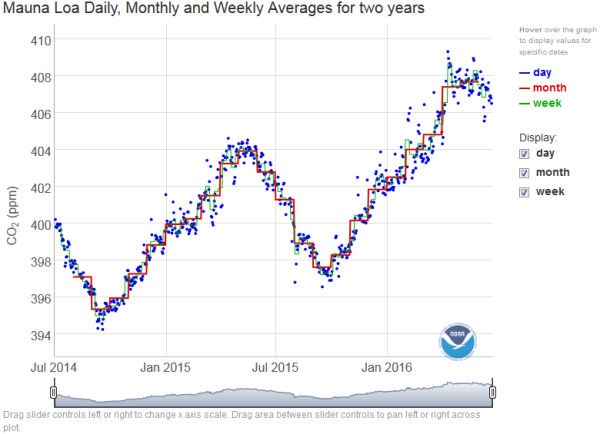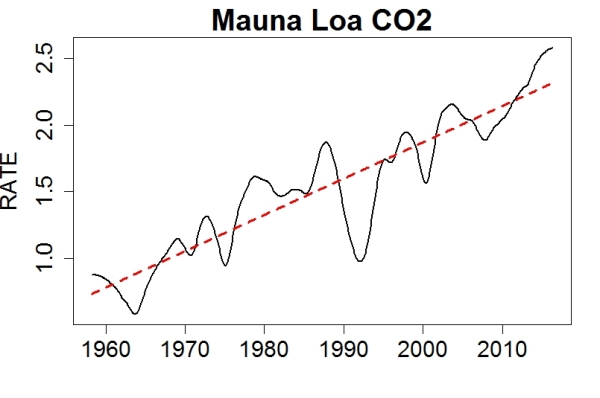CO2’s Vertigo-Inducing Rate of Rise — In First 5 Months of 2016 Hothouse Gas Concentration Rocketed 3.7 Parts Per Million Above 2015
“Perhaps
the most worrisome threat is that because the Arctic is warming so
much faster than the globe as a whole, the permafrost — soil that
remains frozen year-round — is thawing. As it does, organic matter
which is trapped within can decay, and when it does it releases
CO2 into the atmosphere, except those places where instead of
releasing CO2 it releases CH4.”
---Tamino
22
June, 2016
With
the Northern Hemisphere Pole warming at a rate 2-3 times faster than
the rest of the globe, there’s a risk that we start to set off a
kind of runaway warming feedback. We may be near that threshold now…
God help us if we’ve crossed it…
*****
Prior
to 2015, the highest annual rate of atmospheric CO2 increase occurred
in 1998 at 2.9 ppm. This record was broken in 2015 when atmospheric
CO2 levels climbed by 3.05 ppm. But so far this year, the rate of
increase for this heat-trapping gas is a stunning 3.68 parts per
million above comparable monthly averages seen during 2015. That’s
nearly four times the rate of atmospheric accumulation since the
early 1960s. A level of increase that almost guarantees that 2016
will shatter 2015’s record for CO2 gain and set a new ominous
benchmark for a ramping accumulation of hothouse gasses.
(Big
jumps in month to month, 2015 to 2016 CO2 concentrations make it
almost certain that the annual rate of increase in this greenhouse
gas’s concentration will be a new global record. Image source: NOAA
ESRL.)
Human
Fossil Fuel Burning, A Carbon Saturated Ocean, and Amplifying
Feedbacks
The
baseline driver for this amazing rate of increase is a global carbon
emission in the range of 13 billion tons every year (a rate that is
about 30 percent faster than during 1998). Efforts on the part of
China and the rest of the world to curtail coal emissions did result
in a leveling off of these human emissions during 2014 and 2015. But
this action only managed to achieved a plateau in the rate at which
heat-trapping gasses hit the atmosphere at or near new record high
levels. A
rate of emissions that is about ten times faster than the out-gassing
of heat trapping airs which set off the Paleocene – Eocene
Extinction about 55 million years ago.
Wagging
that baseline was a strong El Nino. During El Nino years, the Tropics
heat up. This results in less CO2 being absorbed by the global
Equatorial Ocean even as droughts and wildfires related to the Nino
climate variation pump more carbon out of the world’s soils and
vegetation.
But
also impacting rate of CO2 rise is
what is now an ongoing set of Earth System Feedbacks related to
human-caused climate change.
The added 1.2 C worth of warming since 1880 that 2016 is likely to
experience helps to amplify the El Nino drought and ocean warming
signal resulting in even less carbon uptake and producing even more
carbon feedback. In addition, oceans saturated with carbon due to
atmospheric CO2 levels hitting near 408 ppm are already able to hold
less of the stuff in suspension. So it takes less relative heat force
to further shut down that uptake. In addition, the warming Arctic is
starting to unearth a number of previously frozen carbon stores. And
record high global temperatures are now generating a weak but
troubling signal that some of these stores may be starting to
release.
Deposits of frozen methane, a potent greenhouse gas, and carbon dioxide lie beneath permafrost in Arctic regions. About a quarter of the Northern hemisphere is covered by permafrost. As the environment warms and the permafrost thaws, these deposits can be released into the atmosphere and present a risk of runaway warming.
(Smoothed
annual rate of atmospheric CO2 increase provided by Tamino shows that
the pace of CO2 accumulation has increased by about 0.25 ppm per
decade since the 1960s. The primary driver of this increase is human
fossil fuel burning. But an increasingly substantial driver is the
saturation of global carbon stores coupled with emerging amplifying
feedbacks. Failure to reduce and halt fossil fuel burning as soon as
possible will result in a worsening and intensifying of these warming
feedbacks — putting at risk a catastrophic runaway warming scenario
that we should strive to avoid at all costs. Image source: Taino.)
In
this context, the big 2016 jump in atmospheric CO2 levels looks
pretty grim. And we’ve seen no respite in June when the first three
weeks were about 4.4 ppm CO2 higher than during the same period in
2015. In fact, it appears that the rate of CO2 drop off for this year
is lagging a bit behind trend line. A reduced pace of loss that looks
pretty bad coming off of such amazing highs for the first five months
of the year and during a time when the carbon-loaded Arctic has been
so ridiculously warm.
Links:
NASA (please
support public, non special interest based science like the fantastic
and often life-saving work done at NASA and NOAA)
Hat
tip to Wili
Hat
tip to John McCormack





No comments:
Post a Comment
Note: only a member of this blog may post a comment.